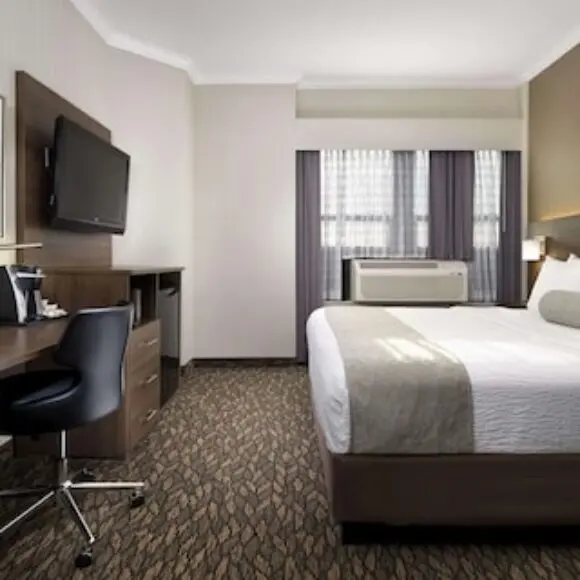Hotel Perfect Brand New Condo In The Heart of Sidney

Perfect Brand New Condo In The Heart of Sidney
Hotel Perfect Brand New Condo In The Heart of Sidney reviews
Planning your ferry trip from Sidney? Stay at Perfect Brand New Condo In The Heart of Sidney; rated and is available from CAD $ 138. Perfect Brand New Condo In The Heart of Sidney is perfectly situated near the ferry routes, and can be reserved directly through Trivago.
📍 Address Perfect Brand New Condo In The Heart of Sidney
9838 Second St, V8L 3C4, Sidney, Canada
FAQ
What is the travel time for the ferry Vancouver route from Nanaimo (Departure Bay) to Horseshoe Bay?
The travel time for the ferry Vancouver route from Nanaimo (Departure Bay) to Horseshoe Bay is approximately one hour and forty minutes. However, it’s always best to verify the exact duration by checking the Nanaimo to Horseshoe Bay crossing times. This crossing time can be affected by weather conditions and other unforeseen circumstances.
How much does it cost to take a vehicle on the Horseshoe Bay to Departure Bay ferry Vancouver crossing?
The cost of taking a vehicle on the Horseshoe Bay to Departure Bay ferry Vancouver crossing is determined by several factors, including the size and type of your vehicle, as well as the time of year. To get precise pricing, it’s best to check the Horseshoe Bay to Departure Bay vehicle fares. Fares typically include a base rate for the vehicle and additional charges for each passenger. During peak season, especially summer months and holiday periods, fares may be higher. It’s also worth noting that fuel surcharges can be added to the total cost.
What are the departure times from Tsawwassen for the Swartz Bay ferry Vancouver route?
The Tsawwassen to Swartz Bay ferry Vancouver route offers multiple daily sailings, with departures varying depending on the season and day of the week. To ensure you have the most accurate and up-to-date information, it’s essential to consult the detailed Tsawwassen to Swartz Bay ferry schedule. Generally, sailings begin early in the morning and continue throughout the day, with increased frequency during peak travel periods. Planning ahead and checking the schedule is crucial, especially if you’re traveling with a vehicle, as reservations are highly recommended.
Ferry Vancouver
Accessibility features ensure all passengers can enjoy ferry travel, with elevators, wheelchair-accessible restrooms, and designated seating areas. Vehicles with accessibility equipment receive priority boarding assistance. Ferry staff provide support for passengers with mobility challenges throughout the journey.
Food and dining onboard ranges from casual cafeterias to full-service restaurants depending on the vessel and route. Local British Columbia ingredients feature prominently in menu offerings. Passengers can also bring their own food and enjoy meals in designated dining areas or outdoor spaces.
Connecting transportation from ferry terminals includes public transit, rental cars, taxis, and ride-sharing services. Victoria’s Swartz Bay terminal connects to downtown Victoria via public bus service. Nanaimo terminals provide access to Island-wide transportation networks for exploring Vancouver Island’s diverse attractions and natural areas.
Ferry reservations are highly recommended, especially during peak summer months and holiday periods when demand significantly exceeds capacity. Advance booking ensures guaranteed passage and reduces waiting times at terminals. Walk-on passengers and cyclists typically have more flexibility, while vehicle spaces often sell out during busy travel periods.
The Tsawwassen to Swartz Bay route is the most popular ferry connection, linking the Vancouver area directly to Victoria, the capital of British Columbia. This 95-minute journey travels through the picturesque Gulf Islands, providing passengers with breathtaking views of islands, mountains, and marine wildlife. The route operates year-round with frequent departures, making it the preferred choice for tourists visiting Victoria’s attractions.
Multi-day Vancouver Island itineraries often begin with ferry travel from the mainland, allowing tourists to explore the island’s diverse regions. Popular destinations include Victoria’s Inner Harbour, Tofino’s surf beaches, and the wine regions of the Cowichan Valley. Ferry connections enable comprehensive island exploration combining urban and wilderness experiences.
Photography tips for ferry passengers include timing outdoor deck visits during optimal lighting conditions and bringing appropriate camera equipment for marine environments. Sunrise and sunset crossings provide particularly dramatic lighting opportunities. Zoom lenses help capture wildlife and distant mountain scenery during the journey.
Duke Point near Nanaimo provides an alternative ferry terminal with connections to Tsawwassen, offering a more southern approach to Vancouver Island. This route is particularly popular with commercial vehicles and RV travelers seeking to avoid downtown traffic. The Duke Point terminal provides easy access to the Island Highway and central Vancouver Island destinations.
Wildlife viewing opportunities during ferry crossings include orcas, seals, dolphins, and diverse seabird species throughout the Salish Sea. The best viewing occurs from outdoor decks, and crew members often announce wildlife sightings over the ship’s public address system. Binoculars enhance the wildlife watching experience during these scenic journeys.
Adventure sports enthusiasts use ferry services to transport kayaks, bicycles, and other outdoor equipment to Vancouver Island’s recreation destinations. Special handling procedures ensure equipment safety during transport. Vancouver Island offers world-class opportunities for surfing, hiking, cycling, and water sports accessible via ferry connections.
Ferry pricing varies by route, season, and vehicle type, with significant differences between passenger fares and vehicle transportation costs. Peak season rates apply during summer months when tourism demand is highest. Multiple pricing tiers accommodate different traveler needs, from foot passengers to large RVs and commercial vehicles.




